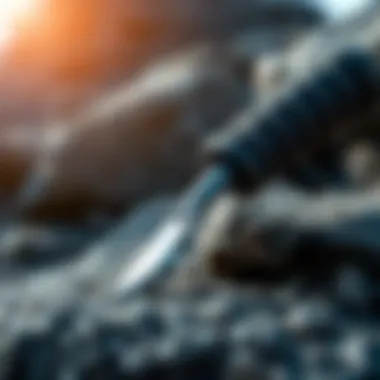Essential Rockhounding Tools and Equipment Guide


Intro
Rockhounding is not just a hobby; it's an adventure that leads one to the earth's treasures, revealing stories woven into the fabric of time. Each stone or fossil holds clues about our planet's history, and understanding the right tools to use can significantly enhance the collecting experience. As enthusiasts dive into rockhounding, knowing what equipment to carry can mean the difference between discovering a hidden gem or returning home empty-handed. This guide aims to illuminate the essential tools and gear needed for effective and safe rockhounding, whether you're just starting off or are a seasoned pro.
History and Origins
Rockhounding has roots firmly planted in our ancestors' quest for resources. The history of collecting rocks and fossils can be traced back to prehistoric times. Early humans collected stones to craft tools and weapons, and later, as societies evolved, this practice transformed into a more aesthetically driven collection of gemstones and fossils.
Overview of Collectibles, Rocks, and Fossils
Throughout history, rocks and fossils have played an essential role in various cultures. For instance, in ancient Egypt, lapis lazuli was not just a stone but a symbol of wealth and power. This gemstone was often used in jewelry and burial items. In contrast, Native American tribes across North America revered certain minerals and stones, integrating them into their spiritual practices. Fossils, too, have had their moments in the sun, often regarded as curiosities or conferred with mystical significance.
Historical Significance and Cultural Impact
The cultural impact of rock collecting can be seen in art, science, and education. Museums worldwide display remarkable finds that help educate the public about Earth's geological history. Such places often house contributions from rockhounds who have helped uncover pieces of the planet's narrative. Additionally, the development of geology as a science in the 18th and 19th centuries encouraged more widespread interest in rock and fossil collecting, leading individuals to explore their local areas for personal discoveries.
"Geology is the science that deals with the earth's physical structure and substance, its history, and the processes that act on it." — Source: Britannica
Identification and Classification
Identifying and classifying rocks and fossils is crucial for rockhounding. Enthusiasts must develop the skills to differentiate various types of specimens, which helps not only in collection but also in understanding the geological processes that formed these items.
Guide to Identifying Rocks and Fossils
To identify rocks and fossils, it helps to consider a few basic characteristics: texture, color, weight, and shape. Field guides can become your best friends here. They often provide clear images alongside descriptions that simplify the identification process.
Common Types and Variations
- Igneous Rocks: Formed from the cooling of magma, these can often appear glossy. Think of granite or basalt, each with its unique textures.
- Sedimentary Rocks: These include sandstone and limestone, usually recognizable by their layered appearance due to sediment accumulation.
- Metamorphic Rocks: Created under pressure and heat, rocks like schist or gneiss can present unique patterns that are quite different from their original forms.
- Fossils: Look for characteristics such as impressions, molds, and casts which indicate organic material.
As you gather more knowledge, the entire experience becomes richer and more rewarding. Rockhounding offers not just the thrill of discovery but a deeper connection to the Earth's history. More information on geological formations can be found at Wikipedia or at local geology clubs on Reddit.
Navigating the world of tools and equipment can perhaps be daunting, but understanding their history and classification lays a solid foundation for your future explorations. The journey into rockhounding is as much about the tools you choose as it is about the rocks themselves.
Prelims to Rockhounding
Rockhounding is more than just a hobby; it's a gateway to understanding the Earth's history through its rocks and minerals. Enthusiasts can spend hours combing through gravel, basking in the thrill of discovery. As one delves into this fascinating world, it becomes clear that having the right tools and equipment can transform a weekend excursion into a successful quest for these natural treasures. This article aims to guide both beginners and experienced collectors in choosing the tools that suit their unique rockhounding needs.
Defining Rockhounding
At its core, rockhounding is the amateur hobby of searching for and collecting rocks, minerals, and fossils. It’s not merely about gathering items; it’s a pursuit that embraces geology, the study of the Earth. Whether one is sifting through gravel beds seeking gemstones or exploring formations for exquisite fossils, rockhounding connects individuals to the environment around them. The excitement stems from uncovering nature's hidden gems, frequently leading to moments of unexpected joy as you unearth something rare.
While many might picture rockhounding as a solitary activity, it often fosters community. Local clubs and groups provide a platform for enthusiasts to gather, share knowledge, and swap stories about their findings. In a way, each collected specimen carries a narrative, telling a story of time, geology, and the processes that shaped it.
The Importance of Tools and Equipment
The tools and equipment used in rockhounding are the unsung heroes of this pursuit. They not only make the process efficient but also safer and more enjoyable. Imagine trying to crack open a tough rock with just your hands or standing for hours without proper footwear; it can turn an exciting day into a challenging ordeal.
Good tools enhance the overall experience. Here are a few key points highlighting their significance:
- Safety: Protective gear like gloves and goggles ensures you avoid injuries while piecing together fragmented specimens. Safety should always be the number one priority.
- Efficiency: Well-designed tools like geological hammers or rock picks make it easier to extract the specimens of interest without damaging them. A sturdy sieve can help in screening finer materials quickly, saving time and effort.
- Enjoyment: Having the right equipment allows for a more relaxed mindset. Instead of worrying about how to break a rock apart, focusing on the discovery transforms the outing into a pleasurable experience.
"Good rocks don’t come to you; you go after them with the right tools."
In summary, the journey into rockhounding begins with a solid understanding of what the activity entails and why having the proper tools is critical. This guide will delve into the essentials of rockhounding gear, helping enthusiasts maximize their experience while exploring the Earth's rich geological tapestry.
Essential Tools for Beginners
When someone decides to jump into the fascinating world of rockhounding, the tools they select are like the foundation of a sturdy house; they set the stage for success in the field. Essential tools for beginners not only serve practical functions but also enhance the overall experience of collecting, examining, and appreciating geological finds. Without the right equipment in hand, one might find that the chances of uncovering interesting specimens diminish.
The importance of equipping newcomers with proper tools can’t be overstated. It helps ensure safety, efficiency, and enjoyment in their rockhounding adventures. For instance, having a geological hammer is crucial when it comes to breaking rocks or releasing crystals from their stony confines. Similarly, a hand lens allows for close examination of minerals and fossils, making the experience all the more rewarding.
Additionally, understanding the use and purpose of each tool helps shape a beginner's approach. Choosing the right equipment not only eliminates unnecessary frustration but also fosters a deeper connection to the land and its history. Here’s a closer look at some of the must-have tools for any budding rockhound.
Geological Hammer
No rockhound's arsenal is complete without a geological hammer. This sturdy tool is specially designed to break rocks without shattering them into jagged fragments. Unlike regular hammers, geological hammers come with a flat end for striking and a pointed end for prying rocks apart.
When you head outdoors, this hammer becomes your best friend. Use the flat face to tap rocks gently, ensuring you don't send chips flying into the great beyond. Meanwhile, the pointed end allows you to explore crevices and prize out your desired specimens. Investing in a quality geological hammer, such as those made by Estwing, can make your rockhounding experience more productive and pleasurable.
Chisels and Points


Complementing the geological hammer are chisels and points. These tools provide precision when splitting rocks or extracting fine specimens that may be embedded in larger formations. Chisels can come in various shapes and sizes, ideal for different tasks. For example, a flat chisel is perfect for breaking flat surfaces, while pointed chisels can help pry loose smaller stones or fossils.
Keep in mind that working with chisels requires a bit of practice. It’s essential to maintain a steady hand to avoid damaging your finds. A few bruises won’t hurt, but your treasures deserve care!
Hand Lens
To appreciate the intricate details of the specimens you collect, a hand lens is indispensable. This simple tool enhances your ability to inspect rocks and minerals, revealing colors, patterns, and textures invisible to the naked eye. A quality hand lens typically magnifies 10x, striking the right balance between power and ease of use.
A hand lens won't just serve you in identifying minerals, but it can spark curiosity, leading to a deeper interest in geology. You'll find yourself marveling at structures within quartz crystals or the unique patterns in agate.
pH Test Kit
If you're serious about understanding the geological environment around you, a pH test kit is a sensible addition to your toolkit. Many rocks and minerals react with certain acids and bases, providing clues about their composition. A simple pH test can help you determine the acidity or alkalinity of soil or water, which can impact the types of minerals you might find in a specific location.
Using a pH test kit is straightforward—just follow the instructions provided to gauge your environment. With this knowledge, you can change your collecting strategy, enabling you to adapt to the geological features that lie ahead.
Intermediate Tools for Serious Enthusiasts
When you dip your toes deeper into the world of rockhounding, the tools you use become more than just instruments; they transform into critical partners in your exploration of the Earth’s treasures. This section highlights the intermediate tools that every serious enthusiast should consider adopting. These tools not only enhance your discovery experience but also teach you more about the geological processes at play, enriching your knowledge and skill set as you delve into this rewarding hobby.
Rock Pick
A quality rock pick is undeniably a fundamental tool that elevates the rockhounding experience. Unlike the average hammer, a rock pick is expertly designed for the task at hand. The slender head of the tool is perfect for embedding in rock crevices, assisting you in prying loose interesting specimens without causing undue damage. It's that fine balance between strength and delicacy that makes a rock pick invaluable. When shopping for one, look for a pick with a comfortable grip and a balanced weight. Some pick heads come with dual-functionality, offering one side for breaking and another for pounding, which can really save time and effort in the field.
A well-chosen rock pick can serve you for years, helping you uncover everything from common quartz to rare mineral specimens. Always keep in mind the durability and quality of materials, as these can dictate how the tool holds up under repeated use.
Sieves and Screens
In the pursuit of finding those fine gem particles, sieves and screens become essential equipment. These tools assist you in sifting through gravel or sediment to separate smaller rocks from finer materials. A good quality sieve allows for effective sorting, making your search more efficient.
When it comes to size, various mesh thicknesses cater to different needs. For example, a coarser mesh works well with larger materials, while finer mesh is ideal for smaller particles. Pairing a sieve with a sturdy bucket can simplify the process – adding just a bit of organization to the chaos of outdoor exploration.
Additionally, it’s worth noting that using sieves and screens helps in the preservation of your finds, as it minimizes the risk of damaging fragile specimens during the search. This approach keeps the excitement alive, increasing the chances of yielding some truly stunning pieces with every dig.
Field Guidebooks
Field guidebooks serve as your best friend while navigating the vast array of minerals and fossils. These references can enlighten you with knowledge about the geological formations you're exploring. Whether it is identifying a specimen or understanding the history of a particular site, a well-curated guidebook can be a treasure trove of information.
When selecting field guidebooks, consider picking ones that not only showcase stunning photographs but also provide in-depth descriptions and locality maps. Regional guides focus on specific areas, whereas more comprehensive ones cover broader topics within geology. Don't shy away from carrying a couple during your excursions; they can provide insights that enhance your understanding of your finds.
"In the field, knowledge is as important as the tools you carry. A solid field guide can be your compass in the pursuit of rockhound mastery."
Navigating through different terrains with a good guidebook isn’t just practical; it’s all part of the adventure. Each page brings you closer to comprehending the remarkable stories of the Earth, making your discoveries much more meaningful.
Advanced Equipment for Expert Collectors
When collectors reach a certain level of expertise, they find that the right tools can make a significant difference in their rockhounding endeavors. Advanced equipment not only enhances the efficiency of collecting but also expands the scope of what can be discovered. For serious enthusiasts, this quality can transform a good day of rockhounding into a spectacular one. In this section, we’ll delve into three main types of advanced equipment: GPS devices, metal detectors, and rock cutting and polishing tools.
GPS Devices
A GPS device is more than just a navigation tool; it can be a rockhound's indispensable companion. The accuracy of modern GPS technology allows collectors to mark the exact locations of prized finds. You can circle back to your favorite spots with precision, ensuring that you don’t miss any hidden gems on your next excursion.
However, not all GPS devices are created equal. It’s wise to consider units that offer rugged designs, as they need to stand up to the outdoor environment. Some features to look for include:
- Durability: The device should withstand drops, moisture, and dust.
- Battery Life: A long-lasting battery is crucial during extended outings.
- Mapping Features: Some devices allow you to overlay topographical maps which can indicate more promising locations for your searches.
In essence, owning a reliable GPS device is like having a treasure map at your fingertips. It enables you to explore areas you might not have ventured into without the assurance of always knowing your position.
Metal Detectors
Metal detectors bring a whole new dimension to rockhounding, especially for those interested in finding not just rocks but also artifacts and minerals. Utilizing electromagnetic fields, these devices detect metallic objects beneath the surface. This can range from coins and relics to valuable minerals, elevating the excitement of your rockhounding quest.
When selecting a metal detector, important factors to consider include:
- Sensitivity Levels: This determines your ability to detect a variety of metals.
- Search Modes: Many detectors come with preset modes tailored to different targets, optimizing your search.
- Weight and Ergonomics: Since you might spend hours using it, a lightweight and comfortable design is crucial.
Advanced metal detectors can distinguish between different types of metals, so you're not digging up junk but rather focusing on potentially valuable finds. These devices can be a game changer for collectors willing to invest the time to learn their intricacies.
Rock Cutting and Polishing Tools
For those looking to elevate their collection presentations, rock cutting and polishing tools are essential. Once you've collected the rough stones, you might want to cut, grind, or polish them to reveal their natural beauty. Understanding how to use these tools can turn raw specimens into stunning display pieces.
Some key tools in this category include:


- Tile Saws: Ideal for cutting various rock types without excessive splintering.
- Lapidary Machines: These machines typically combine grinding and polishing capabilities, allowing for a seamless transition from cutting to finishing.
- Polishing Compounds: Choosing the right compounds will determine the final shine of your stones.
Proper usage of these tools requires practice and patience. However, the rewards are immense as not only do you refine your specimens, but you also deepen your appreciation for the artistry involved in rockhounding.
"The beauty of a stone is not just in its roughness, but in the journey of bringing out its inner light."
Safety Gear for Rockhounding
Engaging in rockhounding is an exhilarating hobby, but it's not without its risks. Because you'll often find yourself in remote and rugged areas, having the right safety gear is not just advisable, it's essential. This section highlights key safety equipment that ensures you can explore with confidence, offering protection against potential hazards while enhancing your overall rockhounding experience.
Protective Gloves
When diving into the world of rockhounding, don’t underestimate the importance of protective gloves. Containing sharp edges and jagged rocks, the environment is rife with potential injuries that could catch the unprepared off guard. A good pair of gloves can shield your hands from cuts, scrapes, and even punctures that can occur when handling rough specimens.
Select gloves made of durable materials like leather or synthetic fabrics, as they provide both sturdiness and flexibility, allowing for dexterous maneuverability while you work with tools or sift through dirt. Moreover, consider choosing gloves with wrist closures to keep dirt and debris at bay. Comfort should be a priority too—if your gloves are too tight or heavy, you might find it hard to grip your tools adequately.
Safety Goggles
Protecting your eyes is crucial, especially when you’re swinging a hammer or chiseling rock. Safety goggles act as a fortress for your eyesight. Flying debris is a constant risk, and one poorly aimed swing can lead to a painful eye injury. Investing in quality goggles helps mitigate these risks.
Look for goggles designed specifically for outdoor work, which are often vented to reduce fogging and enhance visibility. You want them snug yet comfortable enough for extended use. Some even come with additional features like anti-fog coatings or interchangeable lenses for varying light conditions, providing you with adaptable safety as you move from bright sunlight to shaded areas.
Sturdy Footwear
The right footwear cannot be overlooked. Your feet are your foundation, and being out on rough terrain with inadequate shoes can lead to significant discomfort or serious injury. Look for boots or shoes designed for outdoor activity, ideally with supportive soles and protective uppers. Hiking boots, for instance, tend to offer great traction while providing ample ankle support, reducing the risk of sprains.
In addition to comfort and support, water-resistance should also be on your radar. Wet conditions can easily turn a fun expedition into a slippery ordeal. A good pair of waterproof boots ensures foot dryness, which in turn, keeps your morale high during long hours of exploration.
"Whether you’re in it for the thrill of the hunt or the beauty of geology, safety gear is the first step to a successful rockhounding experience."
By prioritizing safety gear in your rockhounding toolkit, you not only safeguard yourself but also set a positive example in the community. Educating fellow rockhounds on the importance of safety equipment assists everyone in enjoying this exhilarating pastime more securely and responsibly.
Maintaining Your Rockhounding Equipment
Maintaining your rockhounding tools is, without question, a critical aspect of enhancing and prolonging their functionality. Just like a diligent mechanic keeps their tools in top shape, rockhounding enthusiasts must put in the effort to ensure that their equipment is ready to tackle the varied challenges they’ll face in the field. Proper maintenance not only improves safety but also ensures that tools perform at their best when you’re out searching for that next prized specimen.
When it comes to rockhounding, the right approach to maintaining your tools can make all the difference. As you handle rocks, your equipment can get caked with dust, dirt, and other substances. Neglecting the upkeep can lead to poor performance, possible injury, and, quite possibly, a hefty replacement bill. Let's dive deeper into the methods that will keep your hammers, chisels, and others in prime condition, whether they’re brand-new or have been used numerous times.
Proper Cleaning Techniques
Cleaning your tools after each use is more than just a good habit; it is essential. The grime from rock surfaces can introduce wear and tear on your tools if it is not addressed. For instance, a geological hammer can gather quite a bit of dust and residue that may corrode the metal if left unchecked.
Here are some specific techniques for cleaning your rockhounding tools efficiently:
- Brushing: Use a stiff-bristled brush to remove loose dirt from all surfaces, especially metal parts. Something like an old toothbrush can do wonders for getting into nooks and crannies.
- Soaking: If there are stubborn materials stuck to tools, soaking them in warm, soapy water for a few minutes can help loosen the buildup.
- Drying Thoroughly: After cleaning, make sure you dry your tools completely. Leaving moisture can lead to rust, particularly on steel implements like chisels and hammers.
Storage Solutions
Even with the best cleaning practices, how you store your rockhounding tools plays a huge role in their longevity. Stowing them correctly can prevent accidental damage and rust build-up, ensuring you can grab them and get straight to the hunt without fuss or hassle.
Tips for smart storage include:
- Tool Boxes: Invest in a sturdy tool box to keep your tools organized and portable. An old fishing tackle box could also serve purpose well.
- Dry Environment: Choose a storage area that is dry and, if possible, climate-controlled. Too much humidity is the enemy of metal tools.
- Separate Compartments: Use dividers or small bags to separate different types of tools to avoid cross-damage, such as a heavy hammer striking delicate chisels.
Repairing Damaged Tools
It’s only natural that tools can suffer wear and tear over time. What matters most is knowing when it’s best to repair rather than replace. A chipped hammer or a cracked handle can still have a life ahead of them with proper attention.
Here's how you can approach repairs on your equipment:
- Duct Tape Repairs: For a quick fix, a little duct tape can keep a handle from splintering further until a more permanent solution is found.
- Replacement Parts: Stock up on replacement parts for tools you frequently use. It’s often cheaper and more sustainable than buying entirely new tools.
- Tools Repair Resources: Visit forums like Reddit Rockhounding or consult websites dedicated to tool maintenance for guides and tips specific to your equipment needs.
"An ounce of prevention is worth a pound of cure." Keeping your rockhounding tools well-maintained ensures that they’ll be reliable and safe when you venture into the great outdoors.
Choosing the Right Tools for Different Environments
When it comes to rockhounding, one size does not fit all. The environment in which you plan to explore significantly impacts the tools and equipment you’ll need. Knowing how to select the right tools tailored to different environments not only enhances your efficiency but can also lead to more successful finds. Each terrain presents unique challenges and opportunities which deserve thoughtful consideration. This section goes through various environments, helping you to identify what’s best suited for each.
Rockhounding in Sedimentary Areas
Sedimentary rock areas are often abundant in fossilized remains and mineral deposits. These terrains are commonly characterized by layers of minerals and sediment, making them a feast for the curious collector. Tools needed here should enable you to gently extract specimens without causing damage.


- Geological Hammer: A light hammer is your best friend in this setting. It provides enough force to tap on rocks without risking major breakage. Aim for a hammer that has a flat striking surface, as it allows for more precise hits.
- Chisels: Avoid using brute force alone; chisels can help in prying delicate specimens from sediments or worn layers.
- Hand Lens: A strong lens aids in identifying details that the naked eye might miss, allowing you to appreciate the unique textures and features of sedimentary rocks.
Exploring these areas often yields a variety of interesting finds such as fossils, clay deposits, or various quartz forms. However, always ensure you have permission to collect in these areas, as many locations are protected.
Exploring Igneous Formations
Igneous rock formations present quite a different landscape than sedimentary zones. These rocks, formed through volcanic activity, are generally much harder and more crystalline. Due to their durability, you’ll need specialized tools to efficiently work through them.
- Rock Pick: This tool is ideal for breaking into tough igneous formations. A heavy-duty rock pick will enable you to chip away at rocks without putting too much muscle into it.
- Safety Gear: Given the chance of flying debris when striking rocks, wearing safety goggles is crucial. Protect your eyes and hands with appropriate gloves.
- Field Guidebook: Having a guidebook handy can also aid in identifying volcanic rock types, such as basalt or granite, helping you understand what you’re looking at and maybe even influencing your collection strategy.
Igneous formations may yield beautiful minerals like obsidian or granite. However, since these rocks are heavier and denser, ensure you are ready for a physical workout while extracting them!
Collecting Fossils
Finding fossils is a thrill that many rockhounding enthusiasts chase. However, fossil-rich areas can often be sensitive to disturbance. Thus, special tools and ethics are involved in this pursuit.
- Soft Brushes: These are essential for cleaning dirt off fossils without scratching or damaging them. Patience is key.
- GPS Device: When searching in specified locations known for fossil finds, keeping track of where you’ve been can help you avoid redundancy and locate the best collecting spots.
- Fossil Field Guide: Familiarizing yourself with fossils native to the area can give you a better chance of recognizing opportunities. You’ll want to know what has been found there previously.
Remember to observe local regulations around fossil collection; some locations have strict rules. Respecting the environment and fellow enthusiasts preserves the experience for everyone.
Always ensure that you know the rules of each area and respect wildlife, as keeping the ecosystems intact contributes to better rockhounding opportunities for the future.
In summary, selecting the right tools to suit the specific environment you’re rockhounding in is paramount. Each of these factors considered will not only enhance your collecting experience but will also enrich your understanding of geology.
Community Resources and Learning Opportunities
Finding a tribe among fellow rockhounding enthusiasts is just as vital as having the right tools. Community resources and learning opportunities amplify the joy of collecting and deepen the understanding of geology behind it. Often, local clubs, workshops, and online platforms serve as incubators for knowledge sharing, fostering new friendships, and helping one feel less isolated in the pursuit of a passion. Whether you're just starting or looking to enhance your skills, tapping into these invaluable resources can be a game changer.
Local Rockhounding Clubs
Joining a local rockhounding club can be like striking gold in your backyard. These clubs bring together individuals who share the same enthusiasm for rocky treasures. Members exchange knowledge regarding local sites, species of minerals, and practical tips for collection.
Consider these important elements when engaging with local clubs:
- Networking: Sharing your experiences and listening to others can deepen your understanding and spark new ideas.
- Field Trips: Clubs often organize trips to dig sites, giving members hands-on experience in various environments. These outings are a classroom beyond the four walls.
- Knowledge Sharing: Experienced rockhounds willingly share their skills and secrets, which can fast-track your learning curve.
"Rockhounding is not just about the rocks; it's about the people you meet along the way."
And let's be honest, there's nothing quite like swapping stories about that one elusive specimen you found in the dirt with someone who's done the same.
Workshops and Seminars
If you fancy diving deeper into specific aspects of rockhounding, workshops and seminars are where it’s at. These structured learning environments can help bridge knowledge gaps. Topics might range from identifying minerals to advanced techniques in fossil preservation.
Benefits of attending these structured sessions include:
- Expert Guidance: Industry professionals and seasoned rockhounds often lead workshops, giving you access to firsthand knowledge that’s hard to come by.
- Hands-on Experience: Practical exercises often accompany lectures, providing you not only with theoretical knowledge but also the chance to apply what you've learned right away.
- Q&A Opportunities: You're likely to have the chance to ask burning questions, clarifying doubts, and gaining insights tailored to your interests.
Consider checking resources such as local colleges or geological societies for upcoming workshops, as they often host events open to the public.
Online Forums and Resources
The digital age has paved the way for various online forums that cater to rockhounding enthusiasts. Websites like reddit.com, where users can immerse themselves in discussions about geology, provide a platform for sharing insights and asking questions in real-time. Moreover, many clubs maintain an online presence, developing community even when members can't meet face to face.
Key elements associated with online resources include:
- Global Reach: Connect with fellow enthusiasts from around the world, broadening your perspective beyond local issues.
- Resource Sharing: Members can share valuable articles, videos, or guidelines that can help you learn without stepping outside your door.
- Accessibility: The online format makes it easy to access materials at your convenience.
You can immerse yourself in thought-provoking discussions in forums or learn from seasoned pros by engaging with them on platforms like facebook.com or through educational domains like *.gov and *.edu.
In sum, leveraging these community resources can significantly enrich your rockhounding experience, offering numerous pathways to learn, network, and grow your passion into something even more fulfilling.
Summary and Culmination
In this comprehensive guide, we’ve traversed the intricate landscape of rockhounding tools and equipment, pinpointing their relevance for enthusiasts at any level. By examining essential tools, safety gear, maintenance practices, and community resources, we’ve crafted a roadmap for both novice rockhounds and seasoned collectors. This summation serves not just as a wrap-up but as a vital reminder of the journey each rockhounding enthusiast undertakes.
Recap of Essential Tools
Let’s take a moment to revisit the core elements that make the rockhounding experience enriching:
- Geological Hammer: A sturdy companion for any rock collector, pivotal for breaking apart rocks to reveal hidden gems.
- Chisels and Points: These precise tools help in more delicate work, allowing for detailed excavation.
- Hand Lens: Essential for scrutinizing the finer details of specimens; it turns the ordinary into the extraordinary.
- pH Test Kit: Crucial for understanding the mineral composition and acidity of soil, guiding rock hounds in prospecting.
- Rock Picks and Metal Detectors: For serious enthusiasts, finding those elusive treasures becomes much easier.
- Safety Gear: Protective gloves, goggles, and sturdy footwear ensure that collectors are equipped to handle the rigors of the field safely.
Taking stock of these tools not only empowers collectors but also spurs their passion for geology.
The Future of Rockhounding Equipment
As we look ahead, the landscape of rockhounding equipment is poised for considerable evolution. With technology as a driving force, here are some trends to keep an eye on:
- Smart Tools: Devices integrated with GPS and augmented reality are on the horizon, promising to enhance the collecting experience by providing real-time data.
- Sustainable Practices: New materials and methods that minimize environmental impact are gaining traction. This will likely include tools made from sustainable resources to align with growing ecological awareness.
- Community Innovations: As rockhounding communities grow, shared tools and resources are expected to become more prevalent, making high-quality equipment accessible to all.



